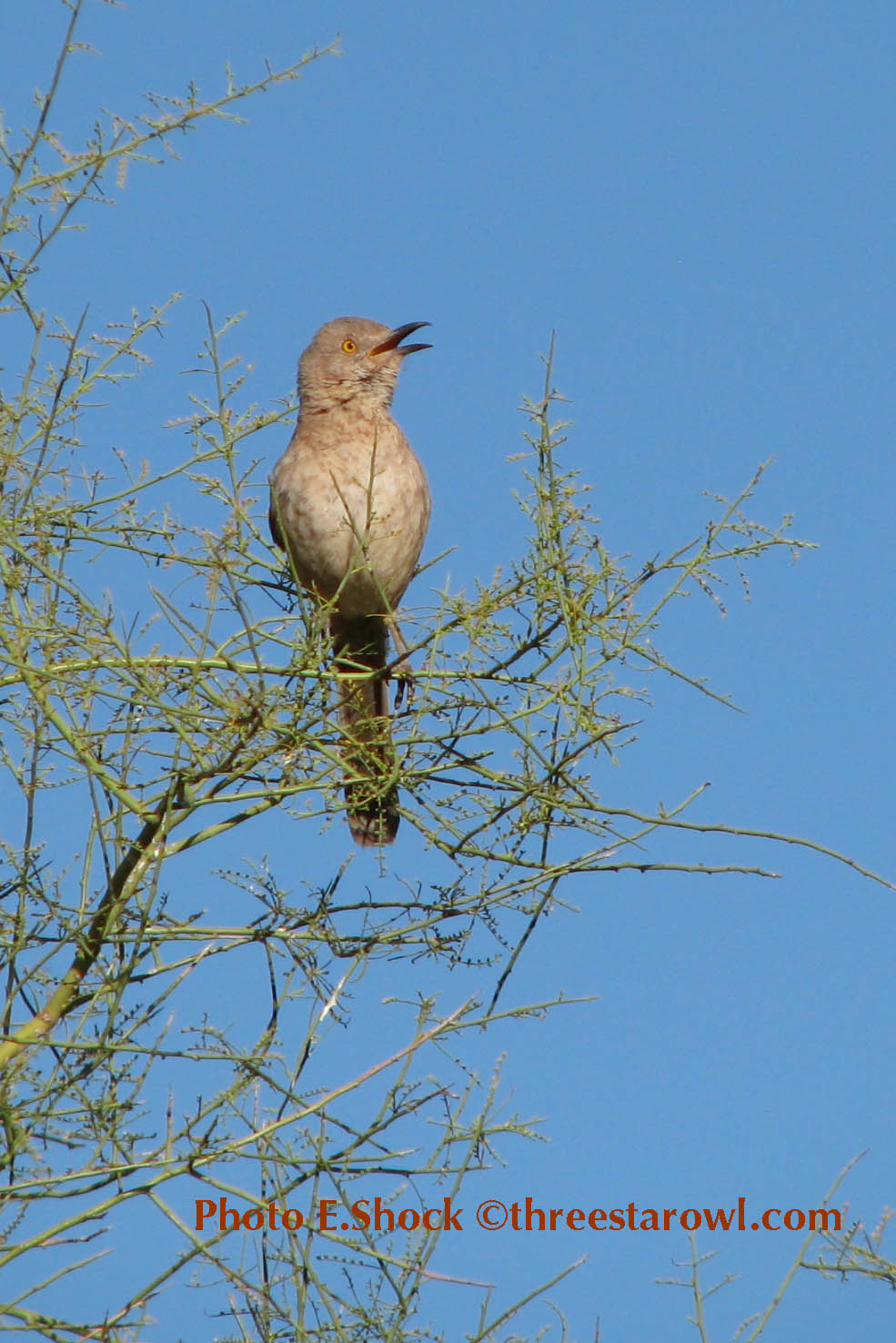Bendire’s thrasher in Papago Park
Some things always amaze me. One of them is why there are so many different Thrasher species in the arid Southwestern U.S.
Most of us who live in the Low Desert are used to two of the more common thrashers: the ubiquitous Northern mockingbird, its slender gray-and-white profile often seen on high perches, singing its  melodious and varied song. Our yard mockers rock their own vocalizations, but also the sounds of other birds, like cactus wrens, cardinals, and kestrels. Our other common thrasher is the larger Curve-billed thrasher. These are busy and athletic foragers, with big down-curved bills and a loud, ringing song. They have a distinctive “wit-weet” call that people are aware of, even if they don’t know the name of the bird who’s making it in their backyard.
melodious and varied song. Our yard mockers rock their own vocalizations, but also the sounds of other birds, like cactus wrens, cardinals, and kestrels. Our other common thrasher is the larger Curve-billed thrasher. These are busy and athletic foragers, with big down-curved bills and a loud, ringing song. They have a distinctive “wit-weet” call that people are aware of, even if they don’t know the name of the bird who’s making it in their backyard.
<< Bendire’s thrasher (Toxostoma bendirei)
But there’s another thrasher, very close in appearance to the Curve-billed, that breeds in the low desert, too, although it’s not as common. It’s the Bendire’s thrasher. Also a plain, mostly brown bird with a vivid and intelligent golden eye, it too has a strong, long bill, less de-curved than the Curve-billed, and pale at the base instead of dark (you can see this subtle field mark in the photo at left, especially if you click to enlarge). It’s perhaps best distinguished by its song, which is “chewier” and to my ear, not as ringing as the Curve-billed.
In the last couple of weeks, E and I have been treated to a very bold Bendire’s thrasher singing from the tops of the sparse trees in a part of Papago Park where we walk several mornings a week. Its chewy, bubbling song attracted our attention; I’m not sure we would have noticed it wasn’t a Curve-billed if we hadn’t heard it.
Bendire’s thrashers are known to inhabit the Park, but we hadn’t encountered one there before, so it’s been a treat for us to enjoy its consistent presence along our route. We had a quick glimpse last week of a second nearby thrasher — it may have been another Bendire’s, so we’re wondering if this stretch of desert isn’t supporting a breeding pair. We’re keeping our eyes open.
Etymology:
Toxostoma, the genus of some of the mimid thrashers like Curve-billed, Bendire’s, Crissal, California, Brown, and LeConte’s, is a compound name formed from two Greek elements, τόξον, bow, and στόμα, mouth, referring to the strong curved bill — in some cases extremely long and curved — of these birds. They use it to turn over foliage and clear crevices of debris by moving it strongly from side-to-side, the action which gives them their type name, thrasher. In search of insects and miscellaneous food items, they ream out all the stuff that settles between flagstones or cracks in the pool deck, leaving a line of turned-up crud along the joints in the cement, so we always know when the thrashers have been foraging there.

When first moved to our present home in a semi-rural area, a friend gave us a birdfeeder she’d made as a housewarming gift. We installed it and put out saucers of water; almost immediately huge groups of quail appeared along with the usual cast of backyard birds. In particular was a California thrasher so aged that his bill curved so much, it was just shy of a half-circle. He had to place his head side-down to dip into the water dish to drink. (the nearest natural water of any kind is about a mile away from us) We dubbed him Grandpa Thrasher and continued to see him for about 5 or 6 more years. Younger thrashers came along, but I’d love to have known just how old he was. His songs were gorgeous, he had quite a repetoire, almost like a mockingbird, many variations in a series. At sundown, when the air was still and other birds were settling down for the night, he’d perch somewhere central and serande the approaching dusk.
It was thrilling to see and hear all the brush-dwelling birds arrive that now make our native shrub borders their home.
California thrashers are excellent birds — with extremely curved bills, as you say — and a species I haven’t seen too many times.
I love the evening songs of our Curved-bills, too; beautiful and elaborate twilight compositions, sung later than other birds’ songs, as you note about the CATHs.